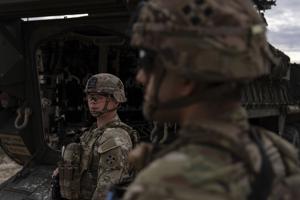
URGENT UPDATE: The U.S. military has dramatically expanded its role at the Mexico-U.S. border, deploying 7,600 troops as illegal crossings hit a historic low. This strategy, spearheaded by President Donald Trump, is unfolding now in Nogales, Arizona, where the military’s presence aims to deter illegal immigration.
Earlier this week, an Army scout at the border detected a man attempting to cross the wall and raised the alarm, prompting swift action from U.S. Border Patrol. The sighting underscores a rare event as apprehensions at the border have plunged to a 60-year low. Army Sgt. Ana Harker-Molina, who immigrated from Panama, noted, “Deterrence is actually boring,” reflecting the slow pace of activity despite the heightened military presence.
The military’s deployment has tripled since early April, involving all branches of the armed forces. This comes as Trump has authorized funding for an additional 3,000 Border Patrol agents, complete with $10,000 signing bonuses, to further bolster border security efforts.
A new command center established at an Army intelligence base in southern Arizona has transformed operations. The command post, now resembling a high-tech war room, coordinates troop movements along the nearly 2,000-mile border with advanced technology, including 117 armored Stryker vehicles and a fleet of drones capable of nighttime surveillance.
Until now, border enforcement has primarily been a civilian responsibility; however, large areas have recently been designated as militarized zones. Troops now have the authority to apprehend individuals trespassing on military properties and can impose criminal charges that may lead to imprisonment.
Maj. Gen. Scott Naumann, overseeing this mission, emphasized the military’s flexibility: “We can deploy rapidly to remote, unguarded terrain,” he stated, highlighting the military’s ability to respond quickly to shifts in cartel activity. Armed soldiers in full combat gear patrol the area, ready to use deadly force if necessary, as they work to prevent “got-aways”—those who evade authorities and disappear into the U.S.
Despite the drop in apprehensions, Naumann insists that vigilance is crucial. He warns that crossings may increase as summer heat wanes. “We’re trending positively,” he said, although the mission has no established end date.
The Trump administration’s use of military resources extends beyond the border. It includes guarding federal buildings in Los Angeles and assisting Immigration and Customs Enforcement in Florida. This approach signals a “muscular” strategy to fulfill campaign promises regarding immigration control, according to legal experts.
Critics argue that this militarization of the border raises legal questions. The deployment may challenge the Posse Comitatus Act, which restricts military involvement in civilian law enforcement. Experts suggest that while the military has the authority to detain individuals on military bases, the current operations exist in a legal gray area.
As the situation develops, communities along the border remain watchful. The heightened military presence is both a deterrent and a contentious point in the ongoing debate over immigration policy in the U.S. Authorities continue to monitor the border closely as they balance enforcement with humanitarian considerations.
Stay tuned for further updates on this evolving story as developments unfold.







